|
Home
Goettingen
in the History of our Family
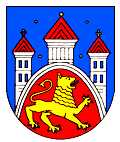
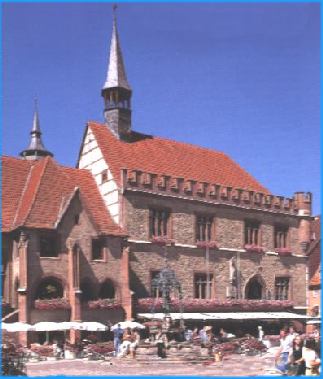 As
we cannot show the complete history of Goettingen or show the city's present
situation we shall concentrate on that part which our ancestors experienced
as contemporaries. As
we cannot show the complete history of Goettingen or show the city's present
situation we shall concentrate on that part which our ancestors experienced
as contemporaries.
Detailed information on Goettingen may
be found through a link on our link-site.
At the beginning of the 20th century Goettingen
entered the life of our forefathers. However, they will have seen the historical
city hall and the market place as it still exists today, one hundred
years later. Only the goose-girls-fountain moved closer to the building.
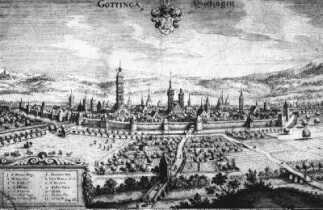 In
953 Goettingen was first mentioned as a village in a document that is still
being kept at Magdeburg. Merchants settled in the 12th century along the
main trade route running north-south in the Leine valley in the vicinity
of the village. 1212 the settlement was declared a township, the market
place was surveyed and a trades hall was built that later became the historical
city hall. The city was fortified with walls and towers. In
953 Goettingen was first mentioned as a village in a document that is still
being kept at Magdeburg. Merchants settled in the 12th century along the
main trade route running north-south in the Leine valley in the vicinity
of the village. 1212 the settlement was declared a township, the market
place was surveyed and a trades hall was built that later became the historical
city hall. The city was fortified with walls and towers.
Goettingen joined the Hanseatic League
and thrived with it. The Protestant reformation was introduced in 1529.
As a Protestant city Goettingen had become a member of the Protestant Union
and suffered with it a defeat in 1547. High retributions, the plague and
the 30-Years-War followed and the township was degraded to a little country
community. The picture shows Goettingen looking from the west in 1610.
The city was lead out of this miserable
situation through the University which was founded in 1734 and started
teaching on 17th September 1737. Today Goettingen is dominated by the University
and has reached world fame through it. Very important people have studied
or taught here.
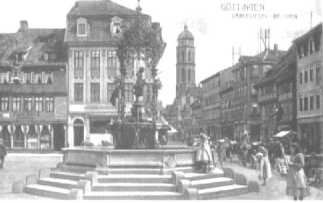 Both
grandfathers of Gerd Hillebrecht found work in Goettingen around 1900,
either at the textile mill or at the railways. Both employed high technology
in their days. This is what the goose-girl-fountain in front of the historical
city hall looked like before the 1st World War. Both
grandfathers of Gerd Hillebrecht found work in Goettingen around 1900,
either at the textile mill or at the railways. Both employed high technology
in their days. This is what the goose-girl-fountain in front of the historical
city hall looked like before the 1st World War.
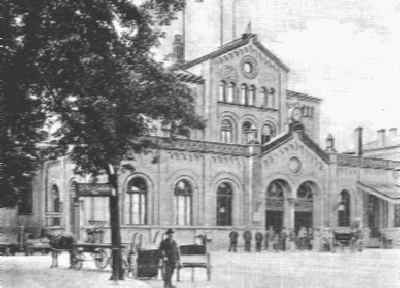 Here
at the railway station of Goettingen began the daily work at the railways
for Wilhelm Hische. This picture shows
it around 1904. Here
at the railway station of Goettingen began the daily work at the railways
for Wilhelm Hische. This picture shows
it around 1904.
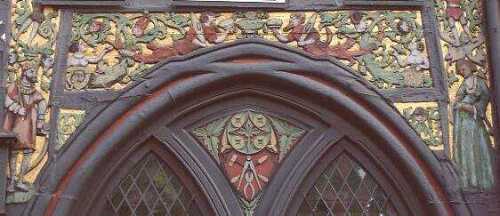
Goettingen took pride in its long textile
(linen weaving) tradition. The figures
above the arch on Schroeder's house of 1549 in Goettingen carry weaving
shuttles.
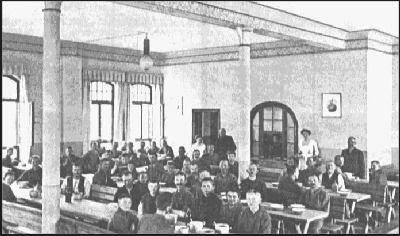
When the old craft practiced at home lost
ground a new textile manufacture was founded by Graetzel. Out of this developed
the textile mill of Levin, in which my grandfather
Hermann
Hillebrecht worked as a young man. The photo pictures employees in
the canteen before 1912. Of the 670 employees 170 lived in Grone.
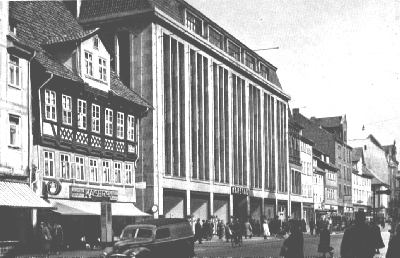 In
Goettingen we spent our childhood, went to school there and began our professional
careers. Finally there is a picture of the largest department store in
Goettingen as it was around 1952. It was here that Walter
Hillebrecht had his last employment as a salesman before the 2nd World
War. In
Goettingen we spent our childhood, went to school there and began our professional
careers. Finally there is a picture of the largest department store in
Goettingen as it was around 1952. It was here that Walter
Hillebrecht had his last employment as a salesman before the 2nd World
War.
|

 As
we cannot show the complete history of Goettingen or show the city's present
situation we shall concentrate on that part which our ancestors experienced
as contemporaries.
As
we cannot show the complete history of Goettingen or show the city's present
situation we shall concentrate on that part which our ancestors experienced
as contemporaries.
 In
953 Goettingen was first mentioned as a village in a document that is still
being kept at Magdeburg. Merchants settled in the 12th century along the
main trade route running north-south in the Leine valley in the vicinity
of the village. 1212 the settlement was declared a township, the market
place was surveyed and a trades hall was built that later became the historical
city hall. The city was fortified with walls and towers.
In
953 Goettingen was first mentioned as a village in a document that is still
being kept at Magdeburg. Merchants settled in the 12th century along the
main trade route running north-south in the Leine valley in the vicinity
of the village. 1212 the settlement was declared a township, the market
place was surveyed and a trades hall was built that later became the historical
city hall. The city was fortified with walls and towers.
 Both
grandfathers of Gerd Hillebrecht found work in Goettingen around 1900,
either at the textile mill or at the railways. Both employed high technology
in their days. This is what the goose-girl-fountain in front of the historical
city hall looked like before the 1st World War.
Both
grandfathers of Gerd Hillebrecht found work in Goettingen around 1900,
either at the textile mill or at the railways. Both employed high technology
in their days. This is what the goose-girl-fountain in front of the historical
city hall looked like before the 1st World War.
 Here
at the railway station of Goettingen began the daily work at the railways
for
Here
at the railway station of Goettingen began the daily work at the railways
for 

 In
Goettingen we spent our childhood, went to school there and began our professional
careers. Finally there is a picture of the largest department store in
Goettingen as it was around 1952. It was here that
In
Goettingen we spent our childhood, went to school there and began our professional
careers. Finally there is a picture of the largest department store in
Goettingen as it was around 1952. It was here that